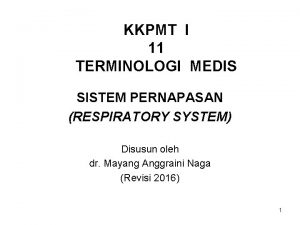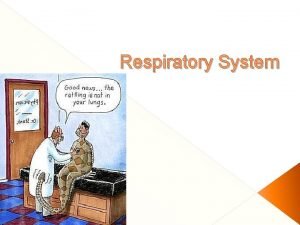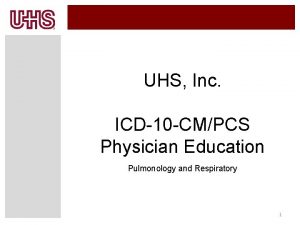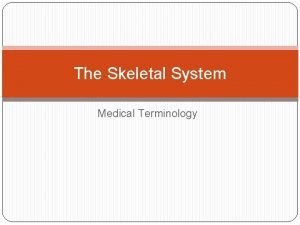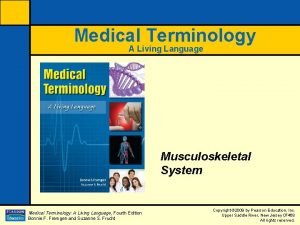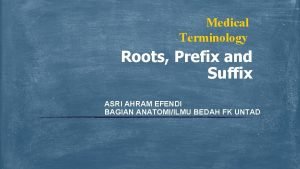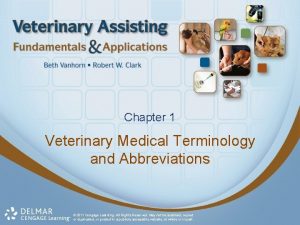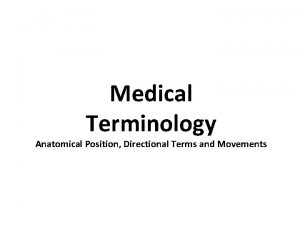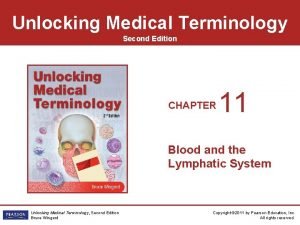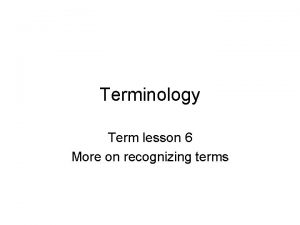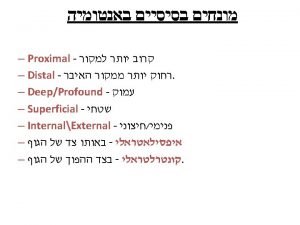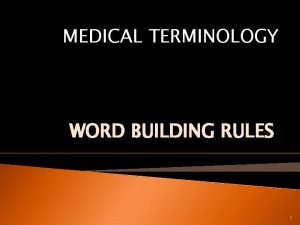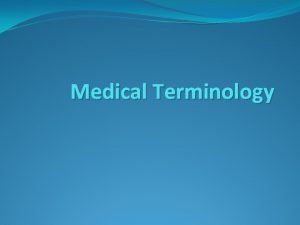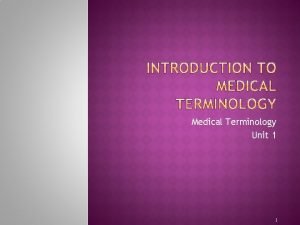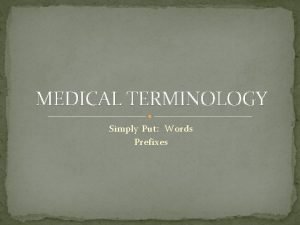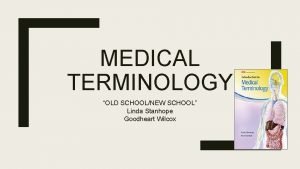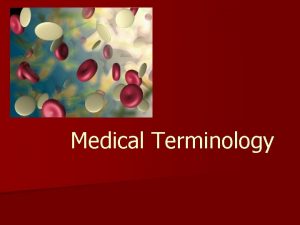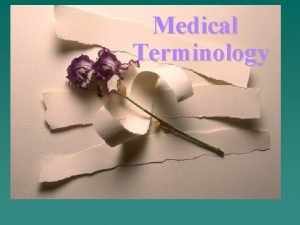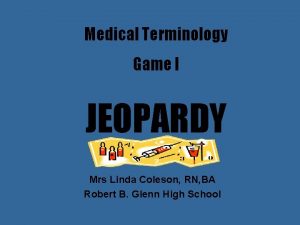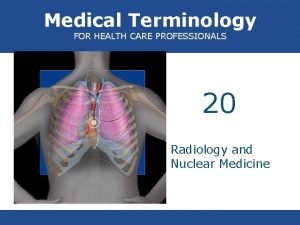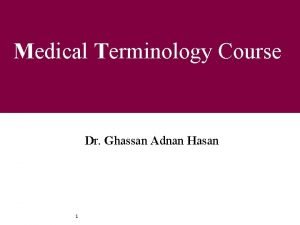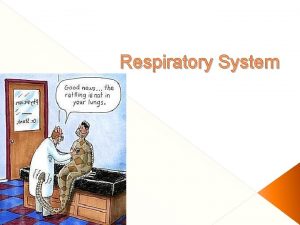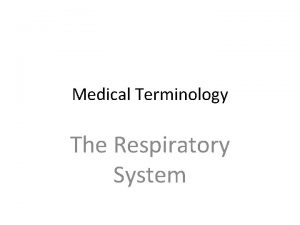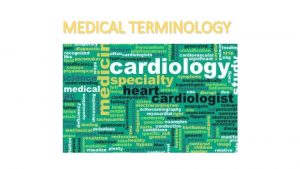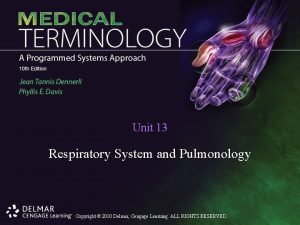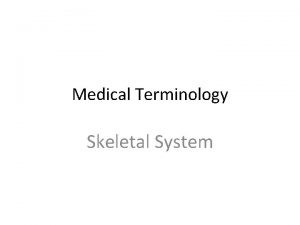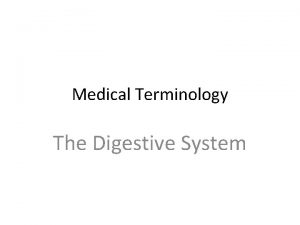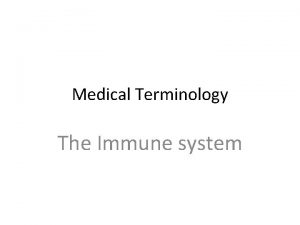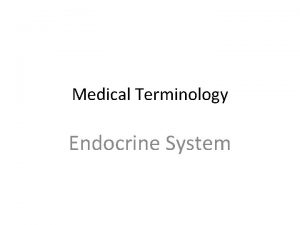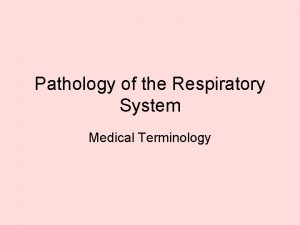Medical Terminology Respiratory System and Pulmonology Pneo pnea






































- Slides: 38

Medical Terminology Respiratory System and Pulmonology

• • Pne/o (-pnea) Pneum/o Pneumon/o -pnea • • Breathing Air (lung) Lung Breathing

Pne/o = Breathing • • • A/pnea Dys/pnea Tachy/pnea Brady/pnea Ortho/pnea • • • Absence of breathing Difficult breathing Rapid breathing Slow breathing Able to breathe only when sitting or standing

Pneumon/o = Lung Pneumon/ectomy: Excision of part or all of a lung Pneumon/o/tomy: Incision of a lung Pneumon/o/pathy: Any disease of the lungs Pneumon/o/rrhagia: Hemorrhage of a lung Pneumon/ia: Acute inflammation of the lungs caused by a variety of organisms and viruses • Pneumon/itis: Inflammation of the lungs • • •

Pneumon/o = Lung • Pneumon/o/centesis, Pneum/o/centesis: Surgical puncture of a lung to remove fluid • Thorac/o/centesis, Thora/centesis: Surgical puncture of the chest to remove fluid • Pneumocystis carinii pneumonia is an infection caused by a protozoan-like organism. Immunodeficient people are particularly susceptible. • Pneumon/o/pexy: Surgical fixation of lung tissue

Atelectasis • Ateles means imperfect in Greek • Ektasis means expand or dilate in Greek • -ectasia, -ectasis: dilation or expansion • Atel/ectasis is the imperfect expansion of the lungs. Collapsed lung. (collapsed alveoli)

Melan/o = Black • Pneumon/o/melan/osis: A lung disease in which lung tissue becomes black due to breathing black dust, soot, or black smoke

Myc/o = Fungus • Pneumon/o/myc/osis: Fungus disease of the lungs – Myces = Mushroom • i. e. mycelium, mycelial • Myc/osis: Any condition caused by a fungus • Myc/oid: Resembling fungi • Myc/o/logy: Science and study of fungi

Myc/o = Fungus • Pharyng/o/myc/osis: Fungal disease (condition) of the pharynx (throat) • Rhin/o/myc/osis: Fungal disease (condition) of the nose • Dermat/o/myc/osis: fungal disease of the skin • Myc/o/dermat/itis: Inflammation of the skin caused by a fungus

Pneum/o = Air • • Pneuma = Wind or breath Pneumon = Lung Pneum/o/derm/a: Collection of air under the skin Pneum/o/thorax: Collection of air in the chest cavity – Pneum/o/thorac/ic (adj. ) • Pneum/o/therapy: Treatment with compressed air

Pneum/o = Air • Pneum/o/meter: An instrument that measures air volume in respiration – Tacho/meter: Measures the number of revolutions per minute of the drive shaft in a car • Pneum/o/ser/o/thorax: Collection of air and serum in the chest cavity • Pneum/o/hem/o/thorax: Collection of air and blood in the chest cavity • Pneum/o/py/o/thorax: Collection of air and pus in the chest cavity


Pulmon/o = Lung • Pulmon/ary, Pulmon/ic: Pertaining to lungs • Pulmon/ary or Pulmon/ic valve is the heart valve through which blood travels to the lungs. Blood flows from the heart to the lungs via the pulmon/ary or pulmon/ic artery. • Pulmonary embolus: A blood clot moving to the lung


• Orth/o = straight • Orth/o/pnea is difficulty breathing if laying straight in a horizontal position. • Hem/o = blood • Ptyal/o = saliva or sputum – P is silent at the beginning of the word in pt- • Hem/o/ptysis is a condition of bloody sputusm • Ptyal/o/rrhea is a flow of saliva.

Term • • A/pnea Dys/pnea Hyper/pnea Tachy/pnea Brady/pnea Ortho/pnea Hem/o/pty/sis Hyper/ventil/ation • Hyp/oxia • Cyan/osis Symptom Absence of breathing Difficult breathing Increased rate and depth of breathing Rapid breathing Slow breathing Able to breathe only when sitting or standing Expectoration (coughing up) blood Excessive movement of air in and out of lungs, sighing respirations • Low oxygen in organs and tissues • Bluish color due to hypoxia • •

Air route • Nas/o – nose, nasal cavity • Pharng/o – Pharynx • Laryng/o – Larynx • Trache/o – Trachea • Bronch/o – Bronchi • Alveol/o – Alveoli The lungs • Covered by the pleura – Pleur/o The diaphragm • Phren/o – Muscle that assists with inhalation and exhalation. • Innervated by the phrenic nerve

Ment/o = Chin • Mentum = Chin • Nas/o/ment/al: Pertaining to the nasal cavity and chin

Nas/o = Nasal cavity • Nas/o/antr/itis: Inflammation of the antrum (maxillary sinus) and the nasal cavity • Nas/al: Pertaining to the nose (cavity) • Nas/itis: Inflammation of the nose (cavity) • Nas/o/scope: Instrument to examine the nose (cavity)

Nas/o = Nasal cavity • Inflammation of nose and pharynx • Pertaining to the nasal and frontal bone • Pertaining to the nose and lacrimal duct • Pertaining to the nose and pharynx Ø Nas/o/pharyng/itis Ø Nas/o/front/al Ø Nas/o/lacrim/al Ø Nas/o/pharyng/eal

Epistaxis • Epi- = upon • Staxis = dripping or oozing • Epi/staxis: nosebleed. Hemorrhage from the nose.

Pharyng/o = Pharynx, Throat • • • Pharynx = Throat Pharyng/o/lith: Calculus in the wall of the pharynx Pharyng/o/myc/osis: A fungus disease of the pharynx Pharyng/itis: Inflammation of the pharynx pharyng/o/cele: Herniation of the pharynx

Pharyng/o = Pharynx, Throat • Incision of the pharynx • Disease of the pharynx • Surgical repair of the pharynx • Instrument to examine the pharynx v Pharyng/o/tomy v Pharyng/o/pathy v Pharyng/o/plasty v Pharyng/o/scope

Laryng/o = Larynx contains the vocal cord Laryng/itis: Inflammation of the larynx Laryng/algia: Pain in the larynx Laryng/o/stomy: Creating a new opening in larynx • Laryng/o/tomy: Incision into the larynx to create a temporary opening • •

Laryng/o = Larynx • Herniation of the larynx • Any disease of the larynx • Instrument used to examine the larynx • Spasm of the larynx o Laryng/o/cele o Laryng/o/pathy o Laryng/o/scope o Laryng/o/spasm

Trache/o = Trachea • Trachea = Windpipe • Trache/o/py/osis: A condition of the trachea with pus formation • Trache/o/rrhagia: Hemorrhage from the trachea • Trache/algia: Pain in the trachea • Trache/o/tomy: Incision into the trachea • Trache/o/cele: Herniation of the trachea

Trache/o = Trachea • Examination of the trachea • Pertaining to the trachea • Incision of trachea and larynx • Surgical creation of a new opening in the trachea • Within the trachea q Trache/o/scopy q Trache/al q Trache/o/laryng/o/tomy q Trache/ostomy q Endo/trache/al

Bronch/o = Bronchi • Bronch/itis: Inflammation of the bronchi • Bronch/o/scope: An instrument to examine the bronchi • Bronch/o/scopy: Examination of a bronchus with instrument • Bronch/o/fiber/o/scopy: Use of a flexible bronchofiberscope to examine the tracheobronchial tree • Bronch/o/lith: Calculus in a bronchus • Bronch/o/stomy: Formation of a new opening into a bronchus

Bronch/o = Bronchi • Bronchial hemorrhage • Spasm of a bronchus • Suturing of a bronchus ü Bronch/o/rrhagia ü Bronch/o/spasm ü Bronch/o/rrhaphy

Pleur/o, (a) = Pleura • Pleur/al: Pertaining to the pleura (membrane around the lungs) – Plural of pleura is pleurae Pleur/itis, Pleur/isy: Inflammation of the pleura Pleur/algia, Pleur/o/dynia: Pain in the pleura Pleur/o/centesis: Surgical puncturing of the pleura Viscer/o/pleural: Pertaining to the membrane attached to the lung • Pleur/o/lith: Calculus in the pleura • Pleur/ectomy: Excision of part of the pleura • •

Phren/o = Diaphragm • Phrenic nerve controls the diaphragm. • Phren/o/plegia: Paralysis of the diaphragm • Phren/ectomy, Phren/ic/ectomy: Removal of a portion of the phrenic nerve

Sinistr/o = Left • Sinistr/ad: Toward the left – Ad-, -ad = Toward • Sinistr/al: Pertaining to the left • Sinistr/o/cardi/a: Displacement of the heart to the left • Sinistr/o/cerebr/al: Pertaining to the left half of the cerebrum • Sinistr/o/man/ual: Left-handed • Sinistr/o/ped/al: Left-footed

Dextr/o = Right • Dextr/ad: Toward the right • Dextr/al: Pertaining to the right • Dextr/o/card/ia: Displacement of the heart to the right • Dextr/o/gastr/ia: Displacement of the stomach to the right • Dextr/o/man/ual: Right-handed • Dextr/o/ped/al: Right-footed

Abbreviation • ABG • AD • AHIMA • • • RHIT AS CO 2 COLD COPD CPR • Arterial blood gases • Right ear (auris dexter) • American Health Information Management Association • Registered health information • Left ear (auris sinister) • Carbon dioxide • Chronic obstructive lung disease • Chronic obstructive pulmonary disease • Cardiopulmonary resuscitation

Abbreviation • • CRT DC DPM HIPPA • • • ICU IS NBRC NMT O 2 PD • • • Certified respiratory therapist Doctor of chiropractic medicine Doctor of podiatric medicine Health Insurance Portability and Accountability Act of 1996 Intensive care unit Incentive spirometer National Board for Respiratory Care Nebulizing mist treatment Oxygen Pulmonary disease

Abbreviation • PE • Peds • PFT • PND • RHIA • RRT • Pulmonary edema, Physical exam, Pulmonary embolism • Pediatrics • Pulmonary function test • Paroxysmal nocturnal dyspnea, postnasal drip • Respiration (rate) • Registered health information administrator • Registered respiratory therapist

Abbreviation • • RT TB TC & DB URI • • Respiratory therapist Tuberculosis Turn, cough, and deep breathe Upper respiratory infection

 Staxis medical term
Staxis medical term Pnea/o medical term
Pnea/o medical term Respiratory medical terms
Respiratory medical terms Dys/pnea
Dys/pnea Respiratory zone vs conducting zone
Respiratory zone vs conducting zone Circularory system
Circularory system Barrel chest
Barrel chest Fcps pulmonology
Fcps pulmonology Uhs pulmonology
Uhs pulmonology Medical terminology skeletal system
Medical terminology skeletal system Scanty urination medical terminology
Scanty urination medical terminology Integumentary system medical terminology
Integumentary system medical terminology Inversion medical terminology
Inversion medical terminology Circulatory system and respiratory system work together
Circulatory system and respiratory system work together Gastric root word
Gastric root word Gastroenteritis prefix and suffix
Gastroenteritis prefix and suffix Veterinary terminology abbreviations
Veterinary terminology abbreviations Sagittal plane other name
Sagittal plane other name Tiny air sacs at the end of the bronchioles
Tiny air sacs at the end of the bronchioles Chapter 11 medical terminology
Chapter 11 medical terminology Proximal lateral distal
Proximal lateral distal Synonymy
Synonymy Medical terminology lesson 12
Medical terminology lesson 12 Phleb prefix
Phleb prefix Throat medical term
Throat medical term Khan cademy
Khan cademy Medical terminology word building
Medical terminology word building Did terms
Did terms Ophthalm medical terminology
Ophthalm medical terminology Esis medical term examples
Esis medical term examples Hepa prefix
Hepa prefix Linda stanhope
Linda stanhope Objectives of medical terminology
Objectives of medical terminology Crine suffix
Crine suffix Long medical words
Long medical words Fun medical terms
Fun medical terms Medical jeopardy questions
Medical jeopardy questions Radiology medical terminology
Radiology medical terminology Accented syllable in retrogastric
Accented syllable in retrogastric


